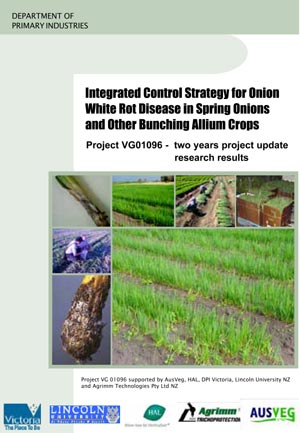|
|
This 16 page report summarises the key outcomes from laboratory and field trials conducted during 2002 to 2004) of project VG 01096 ‘Stop the rot – managing onion white rot in spring onions’. Onion white rot, caused by Sclerotinia cepivorum, can result in severe crop losses in Victoria despite the widespread use of fungicide sprays (procymidone). This is because intensive cropping has led to a build up of disease and high levels of inoculum (sclerotia) in the soil.
Contents :
Acknowlegements : We thank Rocky & Tony Lamattina, Peter Butler, Greg Rankin and Shane Osborne (Mulgowie Qld) for allowing field trials on their properties and helping to maintain and harvest the trials. We also thank Elliott Chemicals Limited and Serve-Ag Research for supplying DADS (Alli-up™ ) and Agrimm Technologies Pty Ltd New Zealand and Rob Stanic for supplying Trichopel Ali52™ .DPI personal. Craig Murdoch for assistance with technology transfer activities. Soheir Salib, Department of Primary Industries, Knoxfield for assistance in establishing and harvesting field trials The authors thank the members of the Steering Committe, Rocky Lamattina, Tony Lamattina, Craig Arnott, Karl Riedel and others for their valuable advice to this project. This project is funded by the National Vegetable Levy (AusVeg), Horticulture Australia (HAL), DPI Victoria, Lincoln University New Zealand and contribution by Agrimm Technology Pty Ltd New Zealand. The Australian Government provides matched funding for all HAL’s R&D activities. |
||||||||
|

